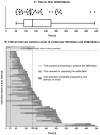Factors associated with delayed defibrillation in cardiopulmonary resuscitation: A prospective simulation study
- PMID: 28594858
- PMCID: PMC5464587
- DOI: 10.1371/journal.pone.0178794
Factors associated with delayed defibrillation in cardiopulmonary resuscitation: A prospective simulation study
Abstract
Introduction: Early defibrillation is an important factor of survival in cardiac arrest. However, novice resuscitators often struggle with cardiac arrest patients. We investigated factors leading to delayed defibrillation performed by final-year medical students within a simulated bystander cardiac arrest situation.
Methods: Final-year medical students received a refresher lecture and basic life support training before being confronted with a simulated cardiac arrest situation in a simulation ambulance. The scenario was analyzed for factors leading to delayed defibrillation. We compared the time intervals the participants needed for various measures with a benchmark set by experienced resuscitators. After training, the participants were interviewed regarding challenges and thoughts during the scenario.
Results: The median time needed for defibrillation was 158 s (n = 49, interquartile range: 107-270 s), more than six-fold of the benchmark time. The major part of total defibrillation time (49%; median, n = 49) was between onset of ventricular fibrillation and beginning to prepare the defibrillator, more specifically the time between end of preparation of the defibrillator and actual delivery of the shock, with a mean proportion of 26% (n = 49, SD = 17%) of the overall time needed for defibrillation (maximum 67%). Self-reported reasons for this delay included uncertainty about the next step to take, as reported by 73% of the participants. A total of 35% were unsure about which algorithm to follow. Diagnosing the patient was subjectively difficult for 35% of the participants. Overall, 53% of the participants felt generally confused.
Conclusions: Our study shows that novice resuscitators rarely achieve guideline-recommended defibrillation times. The most relative delays were observed when participants had to choose what to do next or which algorithm to follow, and thus i.e. performed extensive airway management before a life-saving defibrillation. Our data provides a first insight in the process of defibrillation delay and can be used to generate new hypotheses on how to provide a timely defibrillation.
Conflict of interest statement
Figures



References
-
- Monsieurs KG, Nolan JP, Bossaert LL, Greif R, Maconochie IK, Nikolaou NI, et al. European Resuscitation Council Guidelines for Resuscitation 2015: Section 1. Executive summary. Resuscitation. 2015;95: 1–80. doi: 10.1016/j.resuscitation.2015.07.038 - DOI - PubMed
-
- Perkins GD, Handley AJ, Koster RW, Castrén M, Smyth MA, Olasveengen T, et al. European Resuscitation Council Guidelines for Resuscitation 2015: Section 2. Adult basic life support and automated external defibrillation. Resuscitation. 2015;95: 81–99. doi: 10.1016/j.resuscitation.2015.07.015 - DOI - PubMed
-
- McNally R, Vellano Al V, Pw Y, C S, A C, et al. Out-of-hospital cardiac arrest surveillance—Cardiac Arrest Registry to Enhance Survival (CARES), United States, October 1, 2005—December 31, 2010. Morb Mortal Wkly Rep Surveill Summ Wash DC 2002. 2011;60: 1–19. - PubMed
-
- Soar J, Nolan JP, Böttiger BW, Perkins GD, Lott C, Carli P, et al. European Resuscitation Council Guidelines for Resuscitation 2015: Section 3. Adult advanced life support. Resuscitation. 2015; doi: 10.1016/j.resuscitation.2015.07.016 - DOI - PubMed
-
- Chan PS, Krumholz HM, Nichol G, Nallamothu BK. Delayed Time to Defibrillation after In-Hospital Cardiac Arrest. N Engl J Med. 2008;358: 9–17. doi: 10.1056/NEJMoa0706467 - DOI - PubMed
MeSH terms
LinkOut - more resources
Full Text Sources
Other Literature Sources
Medical

